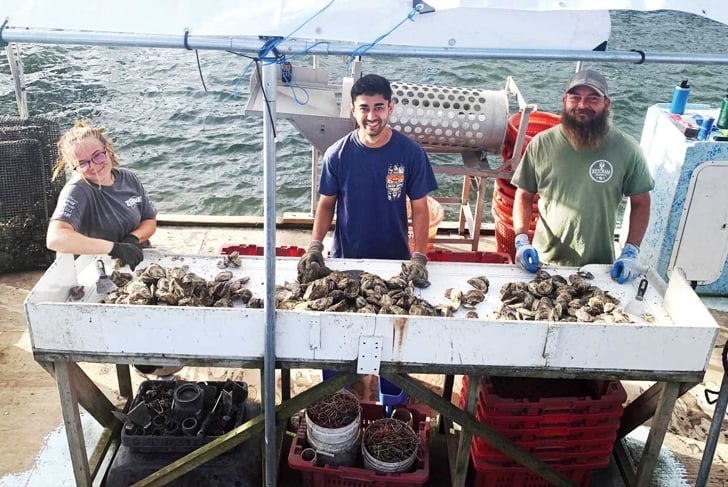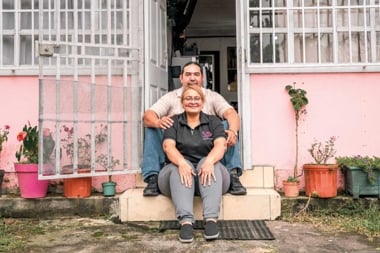
If you have even a passing acquaintance with oysters, you know that the northern coasts of the US are renowned for their delectable shellfish offerings. Oyster aficionados fawn over Beausoleils and Wellfleets from the East, and sing the praises of Kumamotos and Hama Hamas from the West.
But mention the oysters of the Southeast, and noses are turned up, lips pursed, and heads shaken. Second rate oysters from warm waters? Not on my crushed ice platter. Full confession: I was one of those naysayers.
Then a serendipitous encounter with Shark Bite oysters from New Smyrna Beach in Florida opened my eyes (and mouth) to a whole new world. At an Oyster South symposium in St. Augustine, I discovered a passionate cadre of stalwart entrepreneurs whose mission is to restore the reputation of the Southern oyster, create value for their communities, and enhance the local environment.
Gracious invitations were extended to spend a couple of days working down on the farms. So rubber boots in tow and sunblock slathered on, I eagerly headed for the waters of the Atlantic and the Gulf.
It’s all good
The Monterey Bay Seafood Watch puts farmed oysters on their Super Green List as good for you and good for the planet. Dense protein and multiple vitamins and minerals help to support brain health, prevent bone loss, and boost immunity. And oyster aquaculture is associated with a host of ecological benefits to water quality, nutrients, habitat creation, and shoreline stabilization.
Want to do your part? Know your food sources, buy local, and contribute to clean water non-profits.
Day one: On the gulf
“Do you ever see pictures of people not smiling when they are eating oysters?”
It’s a beautiful early morning as Reed Smith of Calusa Oyster Company welcomes me to South Tampa Bay. His young compatriot, Reid Ballard, motors us out to their leasehold as Smith admits that he and his wife Maura basically stumbled upon the notion of oyster farming and said “Hey, we could do that!”
“My family loves seafood so it seemed like a logical thing to pursue,” says Smith. He gestures to the glistening waters and cloudless skies. “Plus, the office is hard to beat.”
Most oyster aquaculture in the Southeast is “off-bottom” in estuaries where tides constantly replenish the nutrients in the water. Bobbing ahead of us are floating cages, each of which holds mesh bags filled with oysters in various stages of growth.
Today’s primary task is harvesting. Dragging up a cage and pulling out a flattened bag turns out to be a strenuous task. Sea life clings around the cage structures, with seaweed, crabs, and tiny fish everywhere. As Smith notes: “Our farm is like a floating reef now.”
The contents of the bags are tumbled through a rotating perforated cylinder, sorting out the smaller oysters and funneling those ready for harvest. Some of those smaller oysters will be donated to a local oyster restoration project, Oyster River Ecology, to support the wild populations that are vital to the health of these waters. Smith articulates the difference: “cultivation” is for consumption, “restoration” is for the environment.
The somewhat tedious task of scraping and sorting allows time for exploring the personal aspects of this life. Ballard explains the passion that drives him: “Growing an animal that sequesters carbon, purifies water, and promotes habitat growth has opened my eyes to how much work still has to be done to make and keep our environment clean.”
And Smith sums it up: “Finding a business that brings so much positivity to people’s lives is such a pleasure and privilege. Do you ever see pictures of people not smiling when they are eating oysters?”
Day two: On the Atlantic
“The farm is truly its own little ecosystem.”
A dock on the Indian River Lagoon is where I am welcomed by Nicolette Mariano of Treasure Coast Shellfish. As our skiff skims out over the clear waters, Nicolette reveals she has been fascinated with aquaculture since she was a 14-year-old volunteer at the Florida Oceanographic Coastal Center. A Bachelor of Science degree provides the underpinnings to her personal enjoyment of her chosen profession. “I love being out on the boat in the early morning, taking in all the sounds and smells… the ospreys, the dolphins, the manatees popping up for a breath of air.”
Back at the dock, her crew slickers up and starts separating and sorting; damaged oysters get thrown into the shallow waters, where multiple species of fish swarm and feed. Mariano reflects on the local benefits that accrue to the farm. “The oysters create this amazing vertical three-dimensional habitat for juvenile organisms; the farm is truly its own little ecosystem. And we have created a number of jobs within our community for people of all ages.”
The challenges
“Try a southern oyster, support a local farmer, taste the difference.”
Mortality events and complicated regulations can be difficult to navigate, but weather is the biggest challenge. Hurricanes wreak havoc on the farms; Smith at Calusa had an entire year’s work decimated by Helene. “It takes persistence, hard work, ingenuity, resilience, and adaptability. We just find a way around or through and keep going.”
Community support is provided by the Florida Shellfish Aquaculture Association, whose Executive Director Adrianne Johnson voices their mission: “Shellfish farmers are some of the hardest working, most resilient and innovative folks I know. We want to uplift this incredible emerging industry in the south and invite people to come be a part of it. Try a southern oyster, support a local farmer, taste the difference.”
In spite of the multiple challenges, Ballard from Calusa speaks for his fellow farmers: “I wouldn’t trade this job for a million dollars.”
Buy direct
For the freshest oysters at home, order directly from the farmers. Local pick-up is best, but shipping works too:
- Taylor Shellfish (taylorshellfishfarms.com)
- Little Wicomico Oyster Co. (lwoysters.com)
- Glidden Point Oyster Farms (gliddenpoint.com)
- Island Creek Oysters (islandcreekoysters.com)
This article was originally published in the November/December 2025 issue of alive magazine (US edition).





